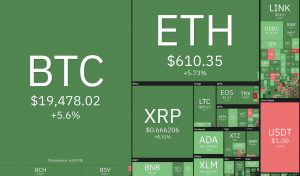Algorithmic trading is an advanced form of trading that uses a computer program to automate the process of buying and selling of either stocks, cryptocurrencies, FX currency pairs, options, or futures. Unlike trading assets directly through a broker, algorithm trading is more accurate and result-oriented as it is designed with a predefined set of instructions that guide it on how to execute trades.
The trades are executed at the exact price and trade volume. This helps eliminate the time lag between placing and execution of the order. Also, all trades are free from human emotions, which may otherwise make a trader give up on profitable trade due to fear or make losses in pursuit of profits. Although the trades are executed automatically, the algorithms used have to be generated by traders in line with their investment goals. The traders key in variables like price, volume, time, and other indicators, which trigger a buy or sell order when specific conditions are met.
Common Algorithm Trading Strategies
Here are some of the most used automated trading strategies that you can explore:
#1 Momentum-based/ trend algo
Momentum and trend is the simplest algorithm trading strategy that aims at capitalizing on a long-running market trend. The idea is that if the market has been moving in one specific direction, upwards or downward, it’ll continue to do so until it’s affected by opposing factors that change its trajectory. A simple momentum-based algorithm, for instance, will invest in the best performing indices based on their performance within a specific duration of time. A more complex strategy blends momentum over time, making use of both absolute and relative momentum indicators. For instance, when the 30-day moving average goes above the 80-day moving average, a buying order is executed; conversely, when the 30-day moving average goes below the 180-day moving average, then a selling order is executed.
As such, momentum algo trading makes use of technical indicators such as the historical price data and trading volume to execute orders. Further, the strategy allows traders to rebalance the system on a weekly, monthly, quarterly, or even yearly basis.
#2 Statistical Arbitrage trading
Statistical arbitrage is an opportunistic trading algorithm strategy that capitalizes on the price differences of assets as listed on various exchanges or markets. For instance, say a security trades at $10 on exchange Y and goes for $9.86 per share on exchange Z. The algorithm will identify this price difference and take a long position of the security in exchange Z, then quickly takes a short position of the same amount of the security on exchange Y.
To realize reasonable profits using this trading strategy, you need to execute high trade volumes frequently since the price differences are almost negligible. However, for the cryptocurrency market, the price differences can be significant due to the difference in demand for crypto within a specific geographical location. For instance, you can buy low-priced crypto from your local exchange and sell it in an overseas exchange where the demand is higher.
#3 Mean reversion
Mean reversion strategy can be used in conjunction with the momentum/trend algorithm to avert losses when the market trends change drastically. Here’s how – while momentum strategy assumes that an asset’s price will continue moving in the same trajectory as it’s currently trending, mean reversion, on the other hand, works under the principle that an asset will always return to its mean value at some point in time regardless of its current high or low trend. The idea here is that the price of an asset will always go back to its historical average price after extreme deviations. Often, these deviations are caused by overselling or overbuying of the subject asset, influencing its price movement.
When using the mean reversion strategy, the algorithm seeks to identify the upper and lower price limits of an asset. When the price is below the lower limit, the algorithm takes a long position and sells when the price goes above the higher limit in anticipation of the price returning to its average value.
#4 Weighted average price strategy
In this strategy, large orders are executed based on either volume-weighted average price or time-weighted average price. The strategy can be executed manually, but the large orders have to be released in small parts, which cannot be humanly possible with as much efficiency and accuracy as that of an algorithm. Besides, to make above-average profits, the orders have to be executed as close as possible to the volume-weighted average price or time-weighted average price to reduce the impact on the market.
#5 Sentiment analysis
Sentiment algorithm trading is quite simple as it doesn’t rely on complex mathematical models to execute orders. It involves examining the general market movements based on the opinions of major stakeholders and traders’ behavior. As such, the algorithm analyzes all types of data from media reports, to social media, to earning reports – and uses this information to predict future price movements upon which orders will be executed.
#6 Building a custom algorithm trading strategy
There are various websites such as CryptoHopper and Bitsgap that offer a variety of trading algorithms which you can then connect to the exchange site of your choice. But, you still have an option to design a unique trading strategy, one that works with your understanding of the market and investment goals. To build an algorithm trading strategy, you need to have proficient programming skills in addition to a good understanding of the quantitative and fundamental analysis of the market.
Once you have these skills, all you have to do is feed your code input variables such as price, trade volume, and other variances that will trigger the execution of orders. Note that, before using your strategy to trade on the real market, you need to run a backtesting program that involves testing the performance of the strategy using historical data. If the strategy brings good results, you can confidently use it to trade in the real market.
Conclusion
Algorithm trading strategies are ideal for both novice investors and traders who are yet to understand the factors influencing market movements. Even the experienced traders can also benefit from the accuracy and efficiency of algorithm trading strategies, which ensures that they don’t miss out on any trading opportunity. However, it is vital to understand that each strategy works differently, and therefore it’s advised to choose one that meets your investment goals.






